 REVIEWED THIS WEEK:
REVIEWED THIS WEEK:
– Hellboy: The
– Spider-Man: House of M #1
– The Black Diamond #1
– Firestorm #14
– The Nail TPB
– G.I. Joe #0
– Action Philosophers All-Sex Special #1
– Vimanarama #1-3
First Look: After a Long Absence, “Hellboy” Creator Mike Mignola Returns to the Beast From Whenst He Came
 I was a little late to the party with respect to Hellboy. In fact, just prior to the film’s release I was scrambling around town like a pyrophobic covered in napalm in a mad attempt to locate and digest all of the source material for the first time. Turned out to be quite the week for me, not unlike I imagine “drinking from the firehouse,” only with Hellboy creator Mike Mignola at the controls instead of Stanley Spudowski. Still, as rushed as it was, it was a lot of fun being introduced to Mignola’s creepy and imaginative world of paranormal detectives and things that go bump in the night. That said, it’ll be nice to take my time for a change and truly appreciate the material with Hellboy: The Island, the latest mini-series in the Hellboy saga.
I was a little late to the party with respect to Hellboy. In fact, just prior to the film’s release I was scrambling around town like a pyrophobic covered in napalm in a mad attempt to locate and digest all of the source material for the first time. Turned out to be quite the week for me, not unlike I imagine “drinking from the firehouse,” only with Hellboy creator Mike Mignola at the controls instead of Stanley Spudowski. Still, as rushed as it was, it was a lot of fun being introduced to Mignola’s creepy and imaginative world of paranormal detectives and things that go bump in the night. That said, it’ll be nice to take my time for a change and truly appreciate the material with Hellboy: The Island, the latest mini-series in the Hellboy saga.
Hellboy: The
There are few working in comics as skilled as Mike Mignola at crafting unique and otherworldly settings, and Hellboy: The Island # 1 is par for the course – that is to say, incredibly atmospheric and stylish. Dark. Intriguing. Gothic. Macabre. All with a little maritime flavor here. Mignola’s sharp and angular linework creates a very refined and classical looking aesthetic. In every panel of this issue there is something unique to appreciate if you just take the time. Simply put, through his visual craftsmanship and prose, Mignola transports the reader to another world. He’s one of comic’s true visionaries.
My appreciation for Hellboy as a character continues to grow with each new project, and The Island has Hellboy at his smart-aleck tough-guy best – rattling off hilarious and stoic one-liners as he rattles the cages of some supernatural nasties. The economy of language here is impressive, especially with respect to the dialogue. If you can say it all with a well placed word here and there, then you should – and that’s part of this character’s charm. A good start to what I imagine will be a great series.
FOUR AND A HALF OUT OF FIVE VIKINGS

First Look: Hamburgers Eat People in Waid and Peyer’s “Spider-Man: House of M”
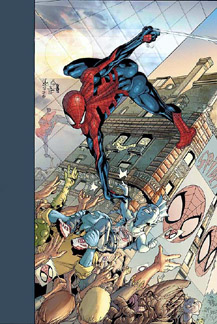 “Nothing will ever be the same,” they say. “We’ll shake the foundations of the universe to its core,” they shout. “Yeah, yeah, yeah,” we shrug.
“Nothing will ever be the same,” they say. “We’ll shake the foundations of the universe to its core,” they shout. “Yeah, yeah, yeah,” we shrug.
And so it goes, in this crazy world we call comics, where the publishers try their level best to excite an increasingly jaded audience base. Sometimes, it’s new number ones, sometimes it’s a high-profile mini-series. Sometimes, it’s a good, old-fashioned line-wide crossover. Both Marvel and DC have caught the bug, and currently it’s a battle of the bulge, as each company tries to outdo the other in terms of tie-ins and marketing ploys.
In Marvel’s case, they’re offering their latest crossover, called House of M, and next week sees the first of these tie-in mini-series, Spider-Man: House of M # 1. In the first of five issues, writers Mark Waid and Tom Peyer introduce us to a Marvel Universe where up is down, black is white and hamburgers eat people. Not literally, mind you. In the House of M world, though, mutants are the ruling class, humans are the minority, and everything shakes down from there.
Oh, and Spider-Man’s a professional wrestler.
Yeah, you read that right. Before you get up in arms about that, let this humble reviewer remind you that there was a Lee and Ditko story wrapped up in that theme, too.
Taking a bit of a humorous approach to the proceedings, Waid and Peyer extrapolate the logic of that change in Peter Parker’s life—his Uncle Ben is still alive, as his acting manager; J. Jonah Jameson is his press agent; Gwen Stacy is alive, and is his wife. On and on I could list the changes, but that’s really half the fun, and this first issue acts as little more than a travelogue of this alternate world. Having a passing familiarity with the natural universe would help but, regardless, Waid and Peyer do a fine job relating the isolated moments where things seem woogy in Peter’s world. As they do this, they lay the foundations of foreshadowing so that we can get onto the business of Setting Everything Right, as this type of story is wont to do. Some really nice moments stand out, though, such as Jameson bitching out a mutant security guard, and Gwen giving Norman Osborn a dressing down. Ultimately, that seems the appeal for this type of story: to provide the opportunities for scenes that couldn’t normally occur within the confines of the regular Marvel Universe.
Salvador Larroca, on the art, does feel quite a bit miscast, as he currently seems like Marvel’s go-to artist for these oddball projects. Obviously capable when it comes to staging the scenes, nothing’s terribly uneven with his work, it merely seems uninspired. That said, his line-weight—in this, and other books he’s been doing of late—has taken on a far-too-thin quality that lends his rendering an unfinished look. A comparison of most of the images in the book against the lonely image of Osborn at the end of his scene shows the difference in what I’m talking about. He’s a very capable artist who doesn’t seem too connected to the material, and it shows.
Overall, it’s a fine read, but nothing too terribly exciting. It remains a little difficult to believe the companies when they say these alternate world stories matter, and so far this one’s no different.
TWO AND A HALF OUT OF FIVE VIKINGS

First Issue of “The Black Diamond” Sets the Stage for What Looks to be an Exciting Series
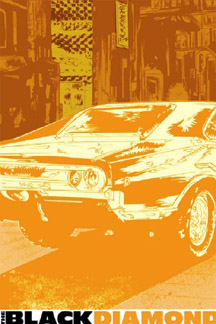 Black Diamond: On the Ramp is one of the more interesting post-apocalyptic stories I’ve read in that (1) it’s not even post-apocalyptic and (2) it intelligently channels the reactionary anxieties of our post 9-11 environment to create the backdrop for a very original story setting. Being a political junkie and, well, quite the fan of the Constitution, I actually spend a considerable amount of time thinking about our post 9-11 world and how it will continue to take shape (or continue to fall apart depending on your point of view). And it never ceases to amaze me what people are willing to surrender in order to feel safe, which is something entirely different from actually being safe.
Black Diamond: On the Ramp is one of the more interesting post-apocalyptic stories I’ve read in that (1) it’s not even post-apocalyptic and (2) it intelligently channels the reactionary anxieties of our post 9-11 environment to create the backdrop for a very original story setting. Being a political junkie and, well, quite the fan of the Constitution, I actually spend a considerable amount of time thinking about our post 9-11 world and how it will continue to take shape (or continue to fall apart depending on your point of view). And it never ceases to amaze me what people are willing to surrender in order to feel safe, which is something entirely different from actually being safe.
In writer Larry Young’s post 9-11 world the federal government has banned all commercial flights, making the fastest way to move goods and people (both legally and illegally) across country The Black Diamond – a federally constructed eight-lane super-highway twenty stories high running from San Francisco to Washington, DC. Needless to say, that’s a lot of road to be policed. At least it would be were the government interested in policing it. Get outside of the major cities and The Black Diamond is devoid of law and order, making armed escorts a necessity and oil barons gods. It’s “The Road Warrior,” while twenty-stories below life goes on – two completely different worlds existing right next to each other, neither one wanting a damn thing to do with the other if they can help it. But when California based Dr. Don McLaughlin needs to get to Baltimore fast, his only option is to deal with The Black Diamond.
I love the premise of this series. It’s clearly the book’s selling point. But reading Black Diamond # 1 is like listening to a waiter describe a twenty-ounce porterhouse and then being told that it won’t be on the menu again until next month. The book is a teaser. It sets the mood and wets the appetite incredibly well. But the substance is only hinted at in a couple pages of exposition at the back of the issue that, quite frankly, read like info-dump. Were this issue one of the twenty-five cent promotional pieces that are all the rage now, I’d be more forgiving. But for three bucks, I was expecting a little more.
That’s not to say that this isn’t a good book, it is, and the series is only going to take off from here. There’s an exciting chase sequence. The themes of desperation and lawlessness are well established. The visuals compliment the story well, appropriately raw and gritty. But things get off to a slow start here. This may be a series that is better read as a trade. Still, Black Diamond # 1 is recommended.
To find out more about this series check out www.ait-planetlar.com.
THREE AND A HALF OUT OF FIVE VIKINGS

“Firestorm” Carries on Nicely with New Writer, Stuart Moore
 Quick history lesson: created by Gerry Conway in the 1970’s, Firestorm was formed when college student Ron Raymond and professor Martin Stein were caught in the midst of a nuclear meltdown. Somehow the radiation caused the two personalities to fuse into one being wearing a red and yellow jumpsuit that could transmogrify any item (except human flesh) into anything else by modifying their base elements. By the end of The Fury of Firestorm, writer John Ostrander had taken Firestorm on a wild ride with the Professor becoming the “fire elemental” (like Swamp Thing is the “earth elemental”), leaving Ronnie with sole possession of Firestorm’s power.
Quick history lesson: created by Gerry Conway in the 1970’s, Firestorm was formed when college student Ron Raymond and professor Martin Stein were caught in the midst of a nuclear meltdown. Somehow the radiation caused the two personalities to fuse into one being wearing a red and yellow jumpsuit that could transmogrify any item (except human flesh) into anything else by modifying their base elements. By the end of The Fury of Firestorm, writer John Ostrander had taken Firestorm on a wild ride with the Professor becoming the “fire elemental” (like Swamp Thing is the “earth elemental”), leaving Ronnie with sole possession of Firestorm’s power.
Scuttled off to limbo and rarely seen since (a forgettable stint in Extreme Justice aside), Firestorm still had a solid collective of fans but no writer could really understand what to do with him. He was a dull, tired, played-out character. Enter Dan Jolley in mid-2004. As a result of a three-page sequence in Identity Crisis, Ron Raymond is killed, last seen exploding in the sky. Detroit teenager Jason Rusch is hit by a fire bolt soon afterwards and, during an intense situation, finds out that he can merge his being with anyone in close proximity in order to become Firestorm.
Much of Jolley’s run would take place inside Firestorm’s head as Jason interacted with this other person, but Jason finds out the hard way that a dominant personality can take over control, and also that the more of Firestorm’s power that is used, the more it eats away at the other person’s essence, killing them unless he lets them go before they are completely “used up”. The possibilities of storylines resulting from Jason essentially kidnapping people and letting them go without memory of being part of Firestorm was a fantastic twist on the character, with Jason’s struggle with an abusive father (the man lost his hand in an accident and has no source of income, so he’s bitter, angry and depressed and lashes out) and his struggle to find money to attend college both motivating factors in his personal life. I highly enjoyed this book.
But Jolley’s gone now, for reasons I’m not sure of, and Stuart Moore (known more for being a Vertigo editor than his writing work) has taken over with issue # 14 of Firestorm, making for a good jumping-on point.
As a result of a previous storyline, Jason, for the time being, no longer needs to merge with someone else to become Firestorm, which, for me, kills much of the potential of the character. Although Moore has diluted some of the interesting elements of the super-hero, he’s carrying on the drama in Jason’s personal life nicely. This issue sees Jason moving in with a buddy and trying to reconcile his feelings about his father, whom he’s felt equally afraid of and sorry for. Jason also snags a summer job at Star Labs: Detroit. Although his job is to help pack the place up as the facility is closing down and it’s jobs are being outsourced to India. The continued interaction with bitter geniuses is certain to create some interesting drama, and be sure to expect a plethora of villains to be created as the facility is torn down and various experiments are let loose.
Issue 14 is not the most engaging issue of Firestorm to date, as it’s obvious that Moore is establishing his take on the characters and the situations he wants to see Jason deal with. I can’t say I like it better than what Jolley had done with the character, but it definitely works as a continuation. The art by Jamal Igle and Rob Stull is very crisp and fluid, although not incredibly dynamic. They handle the plainclothes nicely and have a good handle on relaying emotions. They’re a nice fit for the book. Firestorm has been an incredibly solid super-hero title since issue one and though he missteps a little, it appears Moore knows how to keep the momentum going.
THREE AND A HALF OUT OF FIVE VIKINGS

"The Nail" TPB (Pun Alert) Nails You Down And Has Its Way With You
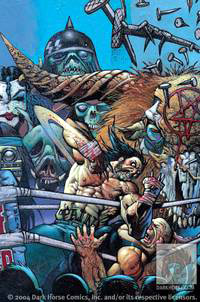 It’s no surprise that Rob Zombie loves to push the envelope. His House of 1000 Corpses was consistently rough on viewers. In that way, it was a more befitting remake of The Texas Chainsaw Massacre than that glossy Hollywood production that actually bears the name. Although the similarities are only apparent on a rudimentary level, Zombie’s 1000 Corpses held onto uncomfortable scenes and extended them long after you were still squirming, recalling key portions of Tobe Hooper’s original masterpiece. That is why the opening five pages of Zombie’s trade paperback of the miniseries The Nail shouldn’t surprise you. Drug use, naked boobies, fellatio, and a beheading are par for the Zombie course, right? Are you kidding? That’s some messed up stuff, man! Of course it surprises you! And that’s just the first five pages!
It’s no surprise that Rob Zombie loves to push the envelope. His House of 1000 Corpses was consistently rough on viewers. In that way, it was a more befitting remake of The Texas Chainsaw Massacre than that glossy Hollywood production that actually bears the name. Although the similarities are only apparent on a rudimentary level, Zombie’s 1000 Corpses held onto uncomfortable scenes and extended them long after you were still squirming, recalling key portions of Tobe Hooper’s original masterpiece. That is why the opening five pages of Zombie’s trade paperback of the miniseries The Nail shouldn’t surprise you. Drug use, naked boobies, fellatio, and a beheading are par for the Zombie course, right? Are you kidding? That’s some messed up stuff, man! Of course it surprises you! And that’s just the first five pages!
Sharing writing credits with Zombie is Steve Niles, who many will recognize as the man returning horror comics to their rightful place. 30 Days of Night and its sequel Return to Barrow have both been reviewed on Thor’s very favorably. The Zombie/Niles writing team is also still releasing the Bigfoot miniseries (issue #4 on your local comic shop shelves now).
“The Nail” that the title refers to is an aging wrestler by the name of Rex, who uses metal pegged-shaped wood-fasteners to rake against his opponents in the ring. Rex is a man, much like Sin City’s Marv, who was born out of time. In another age he’d be a champion commanding respect by his very existence. Today he is a man scraping together a living for his wife and daughter by traveling around the country and wrestling in makeshift rings for sparse crowds. Between bouts Rex and his family and manager encounter, as we all do one time or another, bikers returning from Hell to resurrect their satanic leader by spilling the blood of virgins. So what we get is a modern day warrior fighting paranormal zombie-like leather fiends. With lots of blood. Oh boy, is there lots of blood. Artist Nat Jones spent a lot of time on the splatter effects and we get many splash pages that take the term literally.
Although the four issues this trade collects are available now, the trade itself won’t be released until this Wednesday. If you like wrestlers fighting zombie-demon bikers and lamenting that they’re too old to be doing so, this is definitely your book. If you want a return of the days of EC Comics and for horror to be more available in graphic form, use your dollars to send a message. Or if you just like Rob Zombie’s messed up view of the world, you’ve found a home.
THREE AND A HALF OUT OF FIVE VIKINGS

Joe Casey’s Real American Hero on Display in “G.I. Joe # 0”
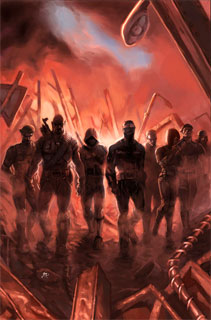 Nostalgia is a funny thing, and standing as one of the last relics of the ‘80s nostalgia boom of the last few years is Devil’s Due’s G.I. Joe. Giving them credit where it’s—ahem—due, the previous iteration lasted forty-some-odd issues before they decided to take the horse behind the barn, shoot it, then hand the reins over to writer Joe Casey so he could find a new steed.
Nostalgia is a funny thing, and standing as one of the last relics of the ‘80s nostalgia boom of the last few years is Devil’s Due’s G.I. Joe. Giving them credit where it’s—ahem—due, the previous iteration lasted forty-some-odd issues before they decided to take the horse behind the barn, shoot it, then hand the reins over to writer Joe Casey so he could find a new steed.
Casey’s long since been a huge favorite of mine, stretching back to his days on Marvel’s Cable—another title I would have loved when I was younger, but as I aged couldn’t really give two figs about. Somehow, Casey made me care, just as he made me care over on Wildcats and a handful of other half-forgotten titles. The man certainly works some magic and, if my theory holds, works his magic particularly well when no one’s noticing and no one cares.
With this introductory issue of G.I. Joe, the magic isn’t quite there, but there’s glimmers of it in the background. When an accident-that-doesn’t-quite-seem-like-an-accident strikes at the heart of Chicago, leaving a wide swath of destruction, the government decides to re-enlist G.I. Joe as their primary, operating strike-force. Disbanded and publicly disavowed at the end of the last series, the new team is smaller, more mobile, more modular and just plain more adaptable than the last. We catch up on some old friends and foes—if you’re familiar with the characters, if not, then we introduce them to you—and set about dealing with the crisis. One of the Joes discovers something troubling about the accident, and then we cut to the final-page cliffhanger that, I imagine, is more shocking if you’re well versed in Joe-lore.
Like I said, not a bad start, but not a revelatory one, either. This didn’t read so much as the definitive G.I. Joe comic you all have been waiting your whole lives for, rather it just reads as a good one. Casey has a confident handle on the Joes and how he sees the team operating, and he spends the bulk of the issue sharing that with the rest of us. Piece of cake. I remember being a bit underwhelmed with the start of his runs mentioned above, and Casey’s always been the kind of writer who builds up steam and then takes off into a long sprint. Though not wholly amazing—the script has some moments of hoary exposition and some hair-trigger tempers just to get the soap opera lathered and bubbly—the writing is solid and dependable. The characters don’t seem particularly differentiated, but I imagine that’ll come with time, since he’s working with a good eight-or-so title characters, and an assorted dozen or so supporting cast members. All within this short amount of space? Yeah, I’ll cut him some slack.
Artwise, Stefano Caselli does an admirable job on the illustrations. His storytelling is solid, with little-to-no flourishes, just worried about getting the job done. Character-wise, there’s a considerable amount of differentiation—both in costuming and in the faces—which is a plus for some young artists, particularly ones that are obviously not working from paused DVDs. Most notable, however, is the color work by Sunder Raj which, while toeing the line of being too computer rendered, manages to keep an even tone and richness throughout. Raj does some really stunning work at setting the mood of each scene, and keeping the feel of each scene unique and different. It brings the art some needed depth and tone, and I like what I see here.
Overall, it’s a bit of a half-step forward for Casey and crew, but it’s a good half-step, and I’m interested to see what they can do with two. (And hey, it’s only a quarter! – Sean)
THREE OUT OF FIVE VIKINGS

“Action Philosophers! All-Sex Special” is Not Nearly as Ribald as You May Think
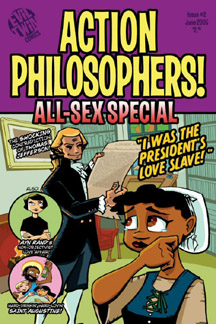 In the mid-1990’s DC Comics created an imprint called Paradox Press, which was intended as a blanket for comics created outside their traditional publishing realms of super-heroes and Vertigo mysticism. Out of Paradox Press came seventeen volumes that comprised the Big Book Of series of oversized “true fact” tomes. The series included, amongst others, the Big Book of the Unexplained, the Big Book of Urban Legends, the Big Book of Scandal and the Big Book of the ‘70’s. Each volume had one or two writers who researched all the stories for the book, distilled them down to their essential elements and then passed them along to the army of artists from all walks of cartooning life. They were brilliant troves of information with a humorous bent, like the Time-Life version of history or a CliffsNotes version of a topic as told by Jon Stewart.
In the mid-1990’s DC Comics created an imprint called Paradox Press, which was intended as a blanket for comics created outside their traditional publishing realms of super-heroes and Vertigo mysticism. Out of Paradox Press came seventeen volumes that comprised the Big Book Of series of oversized “true fact” tomes. The series included, amongst others, the Big Book of the Unexplained, the Big Book of Urban Legends, the Big Book of Scandal and the Big Book of the ‘70’s. Each volume had one or two writers who researched all the stories for the book, distilled them down to their essential elements and then passed them along to the army of artists from all walks of cartooning life. They were brilliant troves of information with a humorous bent, like the Time-Life version of history or a CliffsNotes version of a topic as told by Jon Stewart.
This is exactly what the Action Philosophers! series reminds me of. Written and illustrated by Fred Van Lente and Ryan Dunlavey, each issue features a trio of fables about famous philosophers, giving a brief overview of their life and nice summaries of their major philosophical theories and achievements (often explaining in simpler metaphors so that they actually make sense).
The second issue of the series is the Action Philosophers! All-Sex Special, and it’s not at all as titillating as the title would suggest. Leading off the triptych of stories, we learn about Thomas Jefferson, his great achievements, his views on democracy, his tragic marriage, and his hypocritical views on slavery… not to mention his relationships with his servants. The second feature details Saint Augustine’s wild ways, his loss of all faith and his regaining thereof pushing him to sainthood. Van Lente and Dunlavey even manage to humorously present some of Augustine’s ideologies using thinly veiled versions of the New Gods. The final tale of the book follows Ayn Rand’s journey from Russia to America, her foray into Hollywood, her marriage and her philosophical and completely rationalized love affair. Rand’s concept of “objectivism” and how it relates to societal structures is also outlined amidst all this drama.
Quirky, entertaining and informative, you can’t take the Action Philosophers! as your sole perspective on any of the historical figures they present (a “recommended reading” list is presented inside the back cover), but it’s a good starting ground if you’re thinking of dabbling in philosophy, or getting a head start on that 101 course you’re taking as an elective in college. The art is fun and accessible (solid cartooning work), and the histories are written for easy comprehension (which is no easy task, I’m sure) and bite-sized digestion. If the Action Philosophers! creative team puts out a trade once they get a few more issues under their belt, it will make a nice addition beside the Big Books on any the shelf and/or coffee table and/or bathroom reading rack.
FOUR OUT OF FIVE VIKINGS

Grant Morrison Does Kirby by Way of Krishna in “Vimanarama” # 1-3
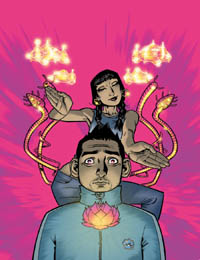 Meet Ali. He’s your typical, twenty-something British-Pakistani art student living underneath the shadow of his filial expectations. On top of that, he’s supposed to wed Sophia, a girl he’s never met in a marriage arranged by his father. Could his day get any worse?
Meet Ali. He’s your typical, twenty-something British-Pakistani art student living underneath the shadow of his filial expectations. On top of that, he’s supposed to wed Sophia, a girl he’s never met in a marriage arranged by his father. Could his day get any worse?
Well, only if he inadvertently unleashes a plague of devils, led by Ull-Shattan, who seek the weapons of the Black Vimanas, with which they plan to annihilate we maggots from this dungheap we call Earth. Which he does.
What’s the upshot, you ask? Sophia’s really cute.
If your eyes glazed over in that second paragraph, it could be a clear sign that we’re delving into a Grant Morrison comic—a Vertigo Morrison comic, at that—so we’re seeing him unfettered and unleashed. Though on the surface a madcap, crazy romp through Morrison’s tortured imagination, the story itself remains fairly grounded. What you’ll find within this three-issue mini-series is a delightfully camp love story set against the backdrop of godlike, Hindu super-heroes fighting their devilish equals over the skies of London and New York City.
When Sophia and Ali go traipsing through the underground tunnels beneath Ali’s father’s store, they find the remarkable traces of a 6000 year old city beneath the surface of their quiet, British town. They unwittingly unleash a plague of devils, described above, as well as the Hindu super-heroes known as the Ultra-Hadeen, led by Prince Ben Rama. Rama believes Sophia to be a reincarnation of his long lost love (think Hawkman in India), and the romantic triangle that forms between Sophia, Ali and Rama serves as the main source of tension…y’know, outside of the “world is being destroyed by rampaging 6000 year old Hindu devils” tension.
Like most of Morrison’s freewheeling, crazified work, there’s a solid backbone of a narrative here. It’s one that finds characters making personal sacrifices in light of the larger world picture, while other characters are unwilling to do the same, despite the knowledge that it could save the world. In short, it breathes. And it does so at a pace that is unmistakably Morrison, and unmistakably fun. Albiet, more fun if you had a minor in Hindu literature, but fun none the same.
Not to be outbid by his writing partner, Philip Bond turns in some refreshingly brilliant artwork. Always a favorite of mine, Bond seems to relish the crazed fury that comes with a Morrison script. Bond manages to create a world that is equal parts cartoony and realistic, where the small-town drama of Ali and Sophia isn’t overshadowed by the gods and monsters destroying half the world in the background. And his character designs on the Ultra-Hadeen and Ull-Shattan’s devils are pitch-perfect—he gives us the perfect blend of Eastern exotic and Jack Kirby’s New Gods.
Like last year’s Seaguy before it, this is a damn fun comic, and if you let yourself get swept away in the fun, and don’t worry yourself none about some of the more cuckoo moments of craziness, you’ll walk away just fine.
FOUR AND A HALF OUT OF FIVE VIKINGS

So ends this accounting of valiant warriors and high adventure! Return next week to honor (maybe) Astro City: The Dark Age, Queen & Country: Declassified and Supreme Power. Praise Odin.
To discuss this column and all things Nordic, you may contact Sean at scfahey@yahoo.com , Devon at thedevonsanders@yahoo.com , Dave at dave@chud.com , Russell at inadvertent@mail.com , Rob at poprob@gmail.com and Graig at graig@geekent.com.
HAVE A COMIC YOU WANT TO SUBMIT FOR REVIEW? Contact Sean at scfahey@yahoo.com.